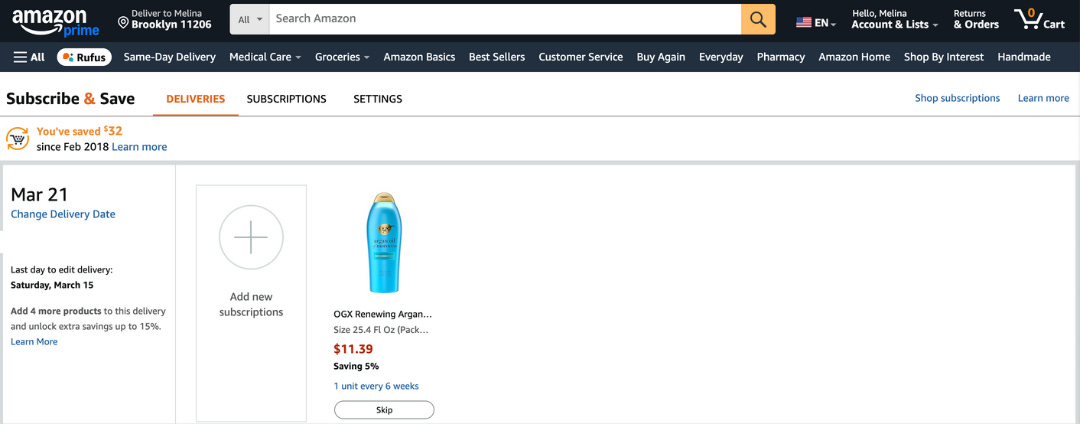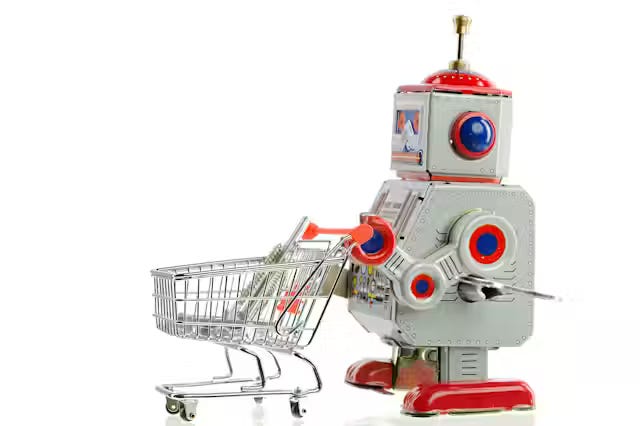Let’s make shopping online fun again!
Introducing the Value x Vibes framework for AI adoption in ecommerce: Part I
Today, almost every online shopping experience follows the same pattern: find a product, add it to your cart, and check out. Whether it’s toilet paper or designer shoes, the product pages look nearly identical.
This familiarity breeds confidence in what was, only a few years ago, a new way of shopping. Ecommerce penetration of retail categories ranges from 12.4% for groceries to 41.6% for categories like apparel and beauty – most purchases are still made in stores. It’s comforting for many to see a consistent, trustworthy flow online from product details through purchase.
The uniformity of ecommerce can make online shopping feel tedious. Giants like Amazon and Walmart offer shortcuts such as Subscribe & Save—which has become increasingly popular—to reduce clicks from discovery to purchase. Yet, when browsing for inspiration, many consumers find these streamlined sites too limiting. They often turn to user-generated content and third-party channels for product research, rather than visiting a brand’s website directly. Just as we work to make our sites more efficient, we also seek to inspire discovery and embrace authentic storytelling.
For years, brands have been exploring new technologies to make our online experiences more fun and engaging on one hand, and faster and easier on the other. Everything from chatbots to express payments has become table stakes. AI tools represent the next wave of opportunities that promise a new level of personalization. In this piece I share a framework for how I believe brands will embrace AI tools, based on how consumers want to shop for different types of products.
Value x Vibes: Making online shopping fun again
I predict that AI will be used differently for different categories of products, based on what we’re looking for when we shop for these products.
I call this the Value-Vibes framework for AI Adoption in ecommerce.
Today, I’ll discuss the left half of this matrix – what I’m deeming boring products – and how we’ll be using AI to buy these.
The Value-Vibes matrix groups products by how expensive they are and how fun they are to shop for.
More expensive products typically require more upfront research, consideration, and comparison and have a longer cycle from initial consideration to purchase. Less expensive products can be a quick trigger – you see something affordable that you like or need, and you may hit “buy” quickly. For a brand, it’s about being in the right place at the right time.
All of us may have different preferences about which products fall where in this matrix. But all of us have categories for which shopping feels like a chore, and others that excite us and inspire us. We will use different tools and engage in different behaviors for different kinds of purchases – and brands should understand how we want to engage when considering how to invest in AI.
Boring/Cheap: Automating every day purchases
In the Boring-Cheap space, consumers are buying everyday purchases. They are seeking convenience and value. Many of these purchases are repeated on a weekly/monthly cadence – think groceries, toiletries, and home products. You may already have subscribe and save set up for some of these products. In this space, AI will primarily be used by customers to automate purchasing - offering convenience, time savings, and price transparency.
AI Shopping Assistants will start to replace subscribe and save and existing grocery delivery services: Boring/Cheap products will be the first purchases that shift to AI Shopping Assistants. As I wrote about in February, there are already AI Operator tools available that can purchase products on our behalf. As these tools become more advanced, we will “outsource” these low-stakes purchases first, gaining confidence in using these tools and building an understanding of the value they deliver.
ChatGPT’s Operator announced that two of their first partnerships are with Instacart and Uber – two platforms that traffic in Boring/Cheap items like groceries and everyday essentials. This is early evidence that platforms see capturing these low-stakes use cases first as critical to changing consumer behavior.
AI Shopping Assistants could improve on the experience of subscribe and save in a few ways. For this example, let’s say that today I have Mrs. Meyer’s all-purpose cleaner delivered monthly via Amazon. In the future, an AI Shopping Assistant may take this flow over for me and could:
Identify better priced options for the same or similar product and swap them out (with customer approval): It might find a deal on Mrs. Meyer’s on Walmart and move my monthly purchase there.
As the product landscape changes, identify products that better fit my needs and suggest them: The AI Assistant would know that I value non-toxic cleaning products. Perhaps if Target releases a well-reviewed private label option that is priced better, it would recommend I move my subscription to this product
Proactively communicate about upcoming orders seamlessly: I envision a more user-friendly dashboard vs. what Amazon currently has. While Amazon has improved this functionality, an AI Assistant could make adjusting and adding to our ongoing subscriptions easier (e.g. making any changes on my behalf based on conversational cues/prompts).
Adjust orders: This includes seamless substitutions when items are out of stock and considering factors like seasonality in subscriptions – “you may use less allergy meds in the winter – do you want to restart that subscription that lapsed now that spring is approaching?”
Reschedule deliveries proactively based on our schedule: “I see you’re away from home these days—should I move your delivery to X date, when you’re back?”
Suggest subscription options based on things we repurchase frequently, highlighting possible cost savings: “you’ve ordered dog food 5x this year. Let me set up a recurring subscription with Chewy and it will save you $100 per year”
What does this mean for brands?
It is already hard for brands to differentiate in the Boring/Cheap space, as many of these products are utility goods. Customers are largely getting these goods from a big marketplace site, like Amazon, Walmart, or Costco vs. transacting on a Brand.com, minimizing the opportunity for unique brand differentiation.
Subscribe & save is a boon for brands in this space, because it allows them to lock in a long-term revenue stream from consumers. In this example, the AI Shopping Assistant challenges that dynamic by introducing flexibility around brand and retailer, and handling the shopping for us. In many cases, consumers would not even see a brand listing – on either Brand.com or retailer site – prior to purchasing.
Brands would need to reach consumers elsewhere, such that I would ask my AI Assistant for Mrs. Meyer’s specifically (a monumental marketing task for small, independent brands). They would also need to optimize their product feeds and content such that they show up in AI Shopping Assistant queries.
What does this mean for marketplaces?
Amazon’s Rufus is a major contender to offer “smart” subscribe & save and take over this role, but isn’t that advanced yet. If ChatGPT, Perplexity, or others continue to advance their shopping capabilities, they could steal some share and become the go-to hub for day-to-day automated tasks. This would be a very powerful position, especially if coupled with non-shopping related tasks, like automating booking travel, appointments, etc. You can see via Operator’s interface that they are heading this way. Personally, I would test out automating some of my “boring” purchases outside of Amazon if I could get value like that described above.
What cheap/boring purchases do you want to automate? Have you experimented with AI yet to do this?
Boring/Expensive: Targeted product research and comparison
While AI can simplify routine buys, its impact on expensive, considered purchases is equally transformative.
There’s a common trope that couples get into fights at IKEA. Why? Because it’s annoying to make big, complicated purchases – where you need to account for the dimensions of your new apartment, your design style, technical jargon, and the measurements of all your other furniture – in a big, crowded place. There is a lot of opportunity for technology to make this easier.
For Boring/Expensive products, we are looking to compare and understand value and tradeoffs. This couch is more expensive, but it’s real leather. Could I resell it when I move? I like this coffee table more, but the shipping is 8 weeks. This TV is bigger, but it’s also thicker and might not look good in my space. What do these vacuum specs even mean? Consumers turn to affiliate sites like Wirecutter to understand the “best” product in each category. With AI, the results will be tailored to highlight the best “for me.”
In this category, product education and comparison are critical, and AI tools are well-positioned to scrape accurate information from brand and retailer sites and summarize it in an intuitive way that can drive to purchase. Taking this to the next level, the tools should align the product specs with your needs and desires. Thus, research is the critical differentiator that customers will use AI for in this category.
What this means for marketplaces and retailers
Trust is paramount in this category. I believe that customers will buy a car with one click in the future. But for them to take this leap, they will need to fully trust the information that AI surfaces – and will need assurances that if something is inaccurate or unclear, they have recourse.
As I wrote about last week, I purchased some shampoo with Perplexity’s shopping tool, which advertised free delivery. When my item was fulfilled, it turned out I was in fact charged for shipping. Small missteps like this can erode trust in AI tools and must be mitigated before these tools can be used for complex purchases like furniture, large appliances, and even cars.
Marketplaces that are perceived to be recommending products in a way that isn’t transparent will receive backlash. I’m very curious to see how paid placements will evolve in the world AI shopping assistants, as they are currently treated as objective arbiters.
Google remains a huge player, with Google Shopping already offering fairly mature research and comparison capabilities that make transacting across retailers sites easy.

Large retailer sites for expensive, technical products, like Best Buy, are surely racing to implement AI tools that enable smart comparison shopping to capture share on their site vs. competitors. A comparison product grid on PDP or PLP doesn’t cut it. They want you to start your search on BestBuy and trust their tool for the best product research restricted to the items on their site only.

As in the Boring/Cheap case, Amazon and AI discovery engines will be working to make their offerings as useful as possible, highlighting products across brands. Perplexity’s partnership with Shopify highlights how it wants to tout independent brands.

Wirecutter and other affiliates are likely to lose out as AI tools evolve in this space. Individual influencers and tastemakers may also be squeezed.
There is also an opportunity for niche players to emerge in this space. Just as the Sears catalog emerged as a trusted place to buy home products in the past, new AI-enabled online catalogs could emerge that offer seamless product comparison, how-to videos, repair support, resale support, and more.
Next week, I’ll focus on the Fun categories – Cheap and Expensive and how AI is disrupting how we shop for these categories.
ICYMI
My last post was about getting AI to do my shopping for me. Check it out!
I let AI do my shopping. Here's what happened.
AI shopping assistants aren’t just recommending what to buy anymore—they’re actually buying things for us. I tested Perplexity Pro and OpenAI Operator to see if AI is ready to take over my shopping… and let’s just say, things got weird.
What I’m Reading & Enjoying This Week
’s piece on Sol de Janeiro’s breakdown of how running brands are growing and differentiating - one of my fave writers on here - shared another banger on what affiliate publishers can learn from Reddit. I trust Reddit for so much information, from parenting to where to go out to eat in NYC. This is such a fascinating topic, especially as Google has prioritized forum results on the SERP. has a great newsletter on AI and everything we need to know about it. I’m also enjoying her podcast as a quick briefing on the AI-related headlines. Stay Curious,
Melina











Love this framework, Melina! Can’t wait for part two.
Thanks for the shoutout! I really enjoyed this piece. I’ll be interested to see how brands continue to experiment with subscribe & save and AI shopping tools. Looking forward to reading your breakdown of the Fun categories!